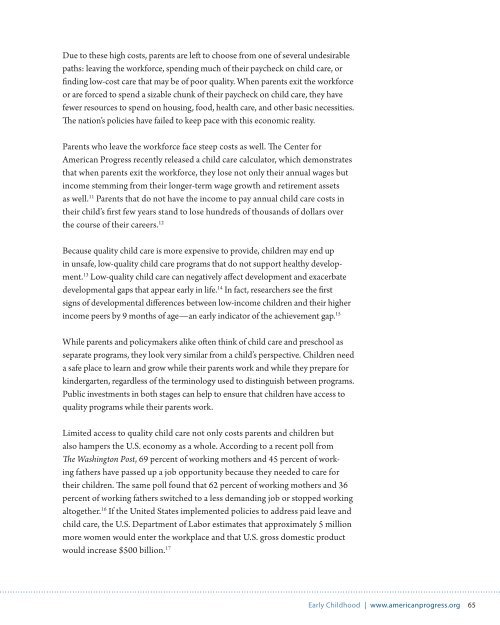AGENCY/PHOTOGRAPHER
RaisingWagesRebuildingWealth
RaisingWagesRebuildingWealth
Create successful ePaper yourself
Turn your PDF publications into a flip-book with our unique Google optimized e-Paper software.
Due to these high costs, parents are left to choose from one of several undesirable<br />
paths: leaving the workforce, spending much of their paycheck on child care, or<br />
finding low-cost care that may be of poor quality. When parents exit the workforce<br />
or are forced to spend a sizable chunk of their paycheck on child care, they have<br />
fewer resources to spend on housing, food, health care, and other basic necessities.<br />
The nation’s policies have failed to keep pace with this economic reality.<br />
Parents who leave the workforce face steep costs as well. The Center for<br />
American Progress recently released a child care calculator, which demonstrates<br />
that when parents exit the workforce, they lose not only their annual wages but<br />
income stemming from their longer-term wage growth and retirement assets<br />
as well. 11 Parents that do not have the income to pay annual child care costs in<br />
their child’s first few years stand to lose hundreds of thousands of dollars over<br />
the course of their careers. 12<br />
Because quality child care is more expensive to provide, children may end up<br />
in unsafe, low-quality child care programs that do not support healthy development.<br />
13 Low-quality child care can negatively affect development and exacerbate<br />
developmental gaps that appear early in life. 14 In fact, researchers see the first<br />
signs of developmental differences between low-income children and their higher<br />
income peers by 9 months of age—an early indicator of the achievement gap. 15<br />
While parents and policymakers alike often think of child care and preschool as<br />
separate programs, they look very similar from a child’s perspective. Children need<br />
a safe place to learn and grow while their parents work and while they prepare for<br />
kindergarten, regardless of the terminology used to distinguish between programs.<br />
Public investments in both stages can help to ensure that children have access to<br />
quality programs while their parents work.<br />
Limited access to quality child care not only costs parents and children but<br />
also hampers the U.S. economy as a whole. According to a recent poll from<br />
The Washington Post, 69 percent of working mothers and 45 percent of working<br />
fathers have passed up a job opportunity because they needed to care for<br />
their children. The same poll found that 62 percent of working mothers and 36<br />
percent of working fathers switched to a less demanding job or stopped working<br />
altogether. 16 If the United States implemented policies to address paid leave and<br />
child care, the U.S. Department of Labor estimates that approximately 5 million<br />
more women would enter the workplace and that U.S. gross domestic product<br />
would increase $500 billion. 17<br />
Early Childhood | www.americanprogress.org 65


